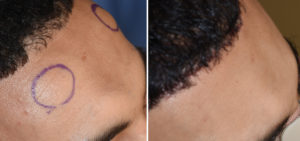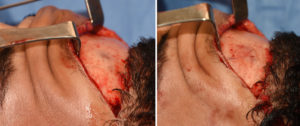Background: The forehead is typically a flap surface above the brow bones. While the angulation of the forehead varies amongst individuals it is still a generally flat surface. The mid and upper forehead is prone to bossing (too much convexity) but usually has few other specific abnormalities.
One type of forehead contour abnormality is that of forehead horns. While there is a skin abnormality known as cutaneous horns, I am specifically referring to the presence of bony exostoses that appear as symmetric paired thickenings of the outer table of the skull. These appear as small bumps at the upper forehead just below the hairline. They seem to be much more common in men than women. Patients so affected often complain about how they appear in different lightings with an obvious light reflex from them.
Case Study: This young male was bothered by a combination of a slightly prominent brow bone and paired forehead horns. Given the need to address the brow bones it was decided to use a frontal hairline incision His frontal hairline had been previously grafted with hair transplants with the orientation of the hairs in an inferior direction, an ideal scenario for a hairline incision.

Forehead horns can be easily remedied by a bone burring method. The only question is how to get to them in an incision-friendly fashion. Some form of a hairline incision always works best due to linear or a direct line of sight access. The further back in the hairline one goes the more difficult it is to work over a convex surface.
Case Highlights:
1) Forehead horns are bony outgrowths or exostoses at the upper forehead and almost always occurs with a bilateral presentation.
2) The method for forehead horn reduction is bone burring.
3) A hairline approach offers the best line of sight approach to their reduction.
Dr. Barry Eppley
Indianapolis, Indiana



